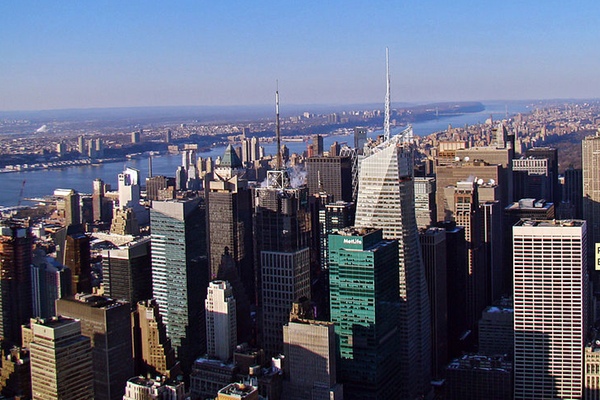Shouldn't the People Who Build Cities Be Able to Live in Them?

In the past few weeks, the headlines glared: “These Are The Foreigners Buying Up American Real Estate,” in Forbes magazine; “Chinese Lead Way as Foreigners Step Up Purchases of U.S. Homes,” in The Wall Street Journal; “Wealthy foreigners trade London homes for New York,” in The Telegraph U.K. And there were headlines in The New York Times. Headlines were not limited to the U.S. real estate. Similar headlines glared in Australia: “One in eight homes now foreign bought, report finds,” in the Sydney Morning Herald. As an amateur genealogist, who has researched and uncovered ancestors in colonial New York, New Yorkers who were both nobles related to the British royals and enslaved African-descended people and workers, I am not surprised that this trend is happening in places that were former colonies. These places have a history of real estate that was owned by a few, mostly royals and nobles, and made oppressive for the masses.
Recently, there has been discussion in New York and other cities about affordable housing for people who are workers. On one side of the discussion is the explosion of expensive luxury housing for the world’s millionaires and billionaires, the 1 percent and the absence of housing affordable to others. But this discussion is graver; it overlooks that renters, lease holders, even high end market renters, those paying premium high rents, are vulnerable in the current market, because they are “renters,” not “owners.”
Places like New York and Australia, former British colonies, have a long history of housing owned by a few, mostly royals and nobles, that was not available to many, mostly the workers and builders of the cities and countries. In New York where I live, I see similarities between the glaring housing headlines and origins of the city as a British colony.
As an artist, I live in Tribeca in lower Manhattan, once an artist district in the shadow of the World Trade Center, within walking distance of Trinity Church on Wall Street. I research history and know the history of Trinity Church, the third largest property owner in the city. Trinity Church was once the only property owner in the city. Royal Commissioner Governor Robert Hunter, who oversaw the city-colony from 1710 to 1720 when Trinity Church was on one end of Wall Street and a slave auction house was on the other end, was my ancestor; his wife, Lady Elizabeth Orby Hay Hunter, is buried in Trinity’s cemetery. I researched the city when my ancestors settled here, and housing was also an issue.
There were battles between large owners and small owners, whether combatants were the Lenape Native Americans and Dutch merchants and soldiers, or Dutch farmers and British soldiers and royals, or owners and lease holders. Tensions existed. When the British royals conquered the Dutch and took foothold after 1664, a few small Dutch farmers tried unsuccessfully to hold on to their properties. So did African Americans, those who were previously enslaved mariners and seafarers who purchased their freedom and who had purchased property from the Dutch West India Company. When Frans Bastiaensz, the son of a slave, Bastiaen D’Angola who had attended to the military officer, Peter Stuyvesant in the Caribbean islands, purchased property (in the center of today’s Gramercy Park) from Governor Stuyvesant’s widow, Judith, he and his heirs lost out in the real estate wars. He had his property taken when the British deemed that African Americans could no longer own property in the city. His heirs lost everything as did the heirs of Dutch farmers who tried to protect their lands in lower Manhattan from the British.
After the Dutch farms were transformed to what was called, the (English) King’s Farms, the heirs of a Dutch farmer, Annetje, lost numerous court cases against the British governors in 1750, 1760, 1807, 1830, 1847. Originally, in 1697, English royals leased New York City-Colony, then called, the King’s Farm, to Trinity Church for “60 bushells of winter wheat.” After Queen Anne was elevated to the throne in 1702, and New York City-Colony was renamed, the Queen’s Farm, as the lands were named after the royals, in 1705 the Queen gave all of the City-Colony’s lands to Trinity Church. The donation included properties formerly called, the Duke’s Farm and the King’s Farm, in effect, all of the island of Manhattan, in “ye Island Manhattans in ye City of New York.”
Decades later, as the City-Colony built and grew, the people I refer to as the workers who built the City, who serviced the merchants, politicians, military officers, governors, gentleman and ladies, struggled to find permanent housing. They were the artisans. They were skilled carpenters, stonecutters, masons, cartmen, grocers, bakers, stoneware craftsmen, mariners, ropemakers, dressmakers, butchers and others. Trinity Church leased lots to them on what was the King’s Farm and the Queen’s farm, and the artisans built houses on the lots. But when the building of the major edifices and streets for Wall Streeters and the wealthy were completed, the leases demanded that workers pick up their houses, place them on their backs and move.
People who build and service the city, whether they were artisans who needed stable, affordable housing or small merchants, artists and entrepreneurs who needed small places to own – were treated badly in the city in different eras. The birth of the city, as now, was one of those eras.